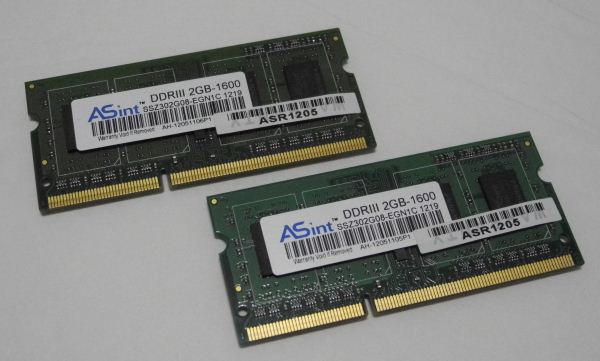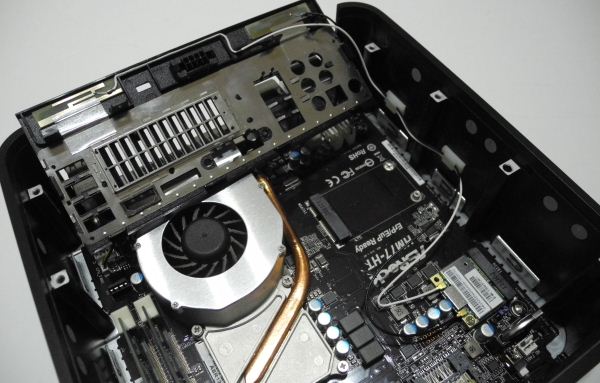ASRock Vision HT: Ivy Bridge Carries the SFF HTPC Forward
by Ganesh T S on November 12, 2012 3:30 PM EST- Posted in
- Home Theater
- ASRock
- HTPC
- Ivy Bridge
System Teardown and Analysis
The ASRock Vision HT 321B is primarily built out of notebook components, and it is quite difficult for the average enthusiast to build such a system with off-the-shelf components.
Motherboard & Chipset : mini-ITX Intel HM77
The motherboard used in the CoreHT series is based on the Panther Point Intel HM77 chipset. There are three SATA headers on the motherboard, with one connected to the hard drive, one to the optical drive and another left unconnected for a second 2.5” drive. The unit also has a mSATA slot. In addition, we also have an eSATA2 port on the rear side of the chassis.
The motherboard exposes four PCIe 2.0 x1 lanes, of which one is connected to the Atheros 9462 WLAN / Bluetooth solution, and the other is connected to the Realtek 8168 GbE controller. As seen in previous ASRock HTPCs, the two sides of the chassis are used as antennae. The two DIMM slots are on the right side of the board, next to the CPU.
CPU : Intel Core i5-3210M
The Core i5-3210M is a 35W TDP processor belonging to the 22nm Intel Ivy Bridge family. Clocking in at 2.50 GHz, it is capable of going up to 3.1 GHz in Turbo mode. The instruction and data caches are 32K each, with a 256 KB common L2 cache. For L3, we have 3MB of Intel Smart Cache shared between the two cores and the integrated GPU.
GPU : Intel HD Graphics 4000
The integrated GPU in the Ivy Bridge processors come in two varieties, namely, HD Graphics 2500 and HD Graphics 4000. The Core i5-3210M uses the latter. It has a base frequency of 650 MHz, and is capable of going up to 1.1 GHz in stressful conditions. It supports full 3D video capabilities, QuickSync v2.0 and WiDi. However, WiDi is not supported by the Vision HT 321B. WiDi makes sense for laptops, but not much for SFF HTPCs. So, we don't fault ASRock for avoiding this feature.
DRAM : ASInt 2 x 2GB DDR3-1600
Compared to the 2x2GB ASInt DDR3-1333 DIMMs used in the CoreHT 252B, ASRock has gone in for an upgrade with a 2x2GB ASInt DDR3-1600 kit for the Vision HT. The memory modules operate at 1.5V with a CAS latency of 11-11-11-28.
Hard Disk : Seagate Momentus Spinpoint 750GB 5400 rpm 2.5"
While the CoreHT 252B used a 7200rpm 500 GB drive, ASRock has opted to increase the storage capacity while bringing down the rotational speed for the Vision HT 321B. The hard drive in the unit is the Seagate Momentus ST750LM022. This drive actually belongs to the Samsung Spinpoint lineup, but Samsung’s hard disk business unit was acquired by Seagate in 2011.
The ST750LM022 isn’t going to win any hard drive benchmarks, but that is acceptable for most HTPC scenarios. Users can always install an additional SSD or mSATA drive as a primary drive for speedy storage.
Optical Disk Drive : Philips Lite-on Blu-ray / DVD RW Slot Loading Drive
The ASRock Vision HT 321B ships with the Philips Lite-on DS-4E1S BD Combo Drive. Unlike last year’s mid-range model, this one sports a slot-loading drive similar to the Vision 3D series. In fact, the drive model is the same as the one shipped with the Vision 3D 137B.
WLAN : Qualcomm Atheros AR5BWB222
ASRock has gone in for a 2T2R dual-band Wi-Fi solution with an integrated Bluetooth 4.0 radio for the Vision HT 321B. In the previous Core series solutions, the sides of the chassis were used as the antennae, but, for the Vision HT 321B, we see that the leads are soldered to the rear end.
As we will see further down in the review, users are in for a much improved wireless performance when the system is used with a capable router.
MCE Remote
ASRock doesn’t include a wireless keyboard / mouse combo with the system. However, we do have an IR receiver in the system, which is taken advantage of by the bundled MCE remote. Unfortunately, the quality of the MCE remote is a big letdown. The keys are quite small and the unit feels cheap in the hand despite being pretty decent in appearance. ASRock has been hesitant to include a better remote despite our repeated requests. Given that the Vision HT series is Bluetooth-enabled, this would have been ideal for ASRock to experiment with a new type of remote.
In the next few sections, we will take a look at the performance of the ASRock Vision HT 321B.














40 Comments
View All Comments
Guspaz - Monday, November 12, 2012 - link
The lack of DisplayPort video output is kind of a big deal... DisplayPort is the only output that the Intel HD 4000 supports high resolution (like 2560x1440 or 2560x1600) over. It will not output these resolutions over HDMI or DVI, as the Intel HD 4000 does not support dual-link DVI.As this is a rather severe shortcoming to a user with a 27" or larger monitor, and users may expect support for this resolution since the chip itself does support it, it should be mentioned in the review. Otherwise, a user might buy this computer only to find out that it doesn't support any 27" monitors...
A better approach would have been for Asrock to include a DisplayPort instead of DVI, and then include a cheap passive DP->DVI adapter in the box. Such adapters are very cheap (under $7 from monoprice), so this would have been an enormously more flexible option.
As the system stands, with no option for a videocard slot, this system can never support large displays.
hughlle - Monday, November 12, 2012 - link
The vast majority of users will be using an HTPC with their HDTV, not a "small" high end moniter, so for the majority of users wanting an HTPC, 1920x1080, as in HD resolutions, is what they will be looking for.methudman6 - Monday, November 12, 2012 - link
It could've been marketed as a "PC-Mini" too if it had display port. I find it strange that they market it so strongly as an HTPC when it looks like it'd make a very nice small computer for casual use.Guspaz - Tuesday, November 13, 2012 - link
There is nothing about this system that makes it an "HTPC" except the cheap remote they include with it, and that's something you can add to any computer for a few dollars. It's just as well suited as a general SFF computer except for this issue. Previous Asrock systems in this identical form factor (and I've used a few of the ION ones for media playback at a large convention) didn't even have a remote.Death666Angel - Tuesday, November 13, 2012 - link
But it also seems like an oversight for Intel to not have DVI 2560 output. What did they gain by that omission?Guspaz - Tuesday, November 13, 2012 - link
Pin count, perhaps? Take a look at the respective pin counts, and I'll exclude hotplug, power, shield, ground, reserved, analog (except on VGA), or optional pins, since none of those would have to be routed to the CPU AFAIK.:DVI: 10 pins
DisplayPort: 10 pins
HDMI: 11 pins
VGA: 12 pins
DVI Dual-Link: 16 pins
I may be excluding some pins that do in fact have to be routed to the CPU, but my basic point is that adding dual-link DVI support would have required adding more pins/traces to the processor, socket, motherboard, etc. That's a non-trivial thing, and from Intel's perspective you can use an adapter to get dual-link DVI anyhow (although at $69 from monoprice, the adapter isn't cheap like the $8 single-link DVI adapter is)
deadlockedworld - Monday, November 12, 2012 - link
Apple should sue!! (seriously though, the shape is almost exactly the same as the previous generation mini)Guspaz - Tuesday, November 13, 2012 - link
The Asrock machines are waaay bigger than the Mini, and the Mini wasn't the first to use that form factor (mini ITX boxes predate it). It was the thinnest of them, to be sure, but not the first.IlllI - Monday, November 12, 2012 - link
wonder what ever happened to those. looks like they dont sell them anymoreGrok42 - Monday, November 12, 2012 - link
I cut the cord/dish 6 years ago. My kids have all grown up not having access to normal television programming. I have a WD-Live x2, Roku x3, iPodses, iPads and iPhones all which can basically access the same media including a 6TB NAS drive. I rip all the kids movies to the NAS drive as soon as we buy them which is 90% of what is on the NAS drive other than home movies and photos. I watch movies from NetFlix, Hulu or rent them on Amazon. I love browsing YouTube from the WD-Live for most of the misc stuff.What else does a HTPC bring to the table that the ~$99 WD-Live doesn't do better and for less? The WD-Live is tiny, has no fans and is Velcroed to the back of my entertainment system. It is plugged into a Wireless N router and can stream 1080P movies with ease. The only thing I can think of is that I can't play PC games or Surf; is there something else?
Not a troll, I sort of feel like I'm making this huge mistake not having an HTPC given my setup but I can never figure out why I would want one.